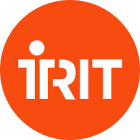etiquetAR is an authoring tool for supporting the design and enactment of mobile context-based learning experiences based on QR tags.
This tool won the Best Demo Award of the ECTEL Conference 2013 and invited to be presented the Online Educa Berlin 2014. Also, a version of the etiquetAR App (developed by Miguel Olmedo Camacho) was selected as a finalist the Telefónica Premios apps contest .
etiquetAR: Tag your learning experience from Mar on Vimeo.
About
etiquetAR is composed of (1) a web application to create, personalize, and manage QR interactive tags, and (2) a mobile App. Although the tags generated with etiquetAR could be read using any third-party QR reader conform with the QR code standard.
Here you will find a Manual of USE.
(1) etiquetAR Web
etiquetAR is an easy-to-use tool that enables creating, managing, and sharing personalized QR tags attachable to any object or physical geographical location to transform any space into an augmented learning space. The final aim of etiquetAR is to encourage practitioners to go beyond the classroom providing them a simple way to create their own tag-based learning experiences.
etiquetAR has the following added values, thus differentiating itself from other QR codes generators:
- Support for creating dynamic QR tags: etiquetAR enables creating QR tags with a fixed image and vary the content whenever the user wants.
- Support for creating tags linking to multiple digital resources: etiquetAR enables to create more than one resource for the same tag and to manage its access through profiles in order to adapt the learning process to any type of learner.
- Support for creating adaptive tags: etiquetAR enables assigning a profile to access the codified information. Each resource in the tag can be assigned to a different profile. This profile determines which resource is shown to the user.
- Support for organizing tags into collections: Tags can be organized into folders, making easier for users to access their tags (i. e. Collection “Moma Museum”, “Botanic garden”, etc.). One tag can be associated to one or more folders.
- The tags can be accessed with any QR reader: Since the tags follow the QR standard, any readers conformed to this standard can read the tags created with etiquetAR.
- Mobile-based support for adding comments to existing tags: Any user can add comments to the resources codified in a tag generated with etiquetAR. Also, any user can see the comments provided by others to a particular resource. The owner of the QR codes can delete and hide any comment.
(2) etiquetAR App
Recently, we have developed the etiquetAR App for Android Mobiles. This app improves the interactions with the tags so as it is easier to read and comment on these tags.
Context of use
Up to now we have already tested the App in several actual educational contexts:
- For supporting exploratory type of experiences with first year university students at the University Pompeu Fabra. Students explored the different areas of the campus interacting with etiquetAR tags.
- For supporting context-based situated collaborative learning in a Lab with Mechanical Engineering Students. etiquetAR tags were used to support reflection and collaboration among students during the lab.
RELATED PUBLICATIONS
- Pérez-Sanagustín, M., Martínez, A., Delgado Kloos C. etiquetAR: Tagging learning experiences, Proceedings 8th European Conference on Technology Enhanced Learning, Hernández-Leo, D., Ley, T., Klamma, ,R. & Harrer, A. (Eds) Lecture Notes in Computer Science, 8095, pp. 625-626. (chapter)
- Pérez-Sanagustín, M., Melero J., Hernández-Leo, D., Delgado Kloos C. Transforming the Campus into a digitally augmented learning space using etiquetAR.Proceedings 8th European Conference on Technology Enhanced Learning, Hernández-Leo, D., Ley, T., Klamma, ,R. & Harrer, A. (Eds) Lecture Notes in Computer Science, 8095, pp. 573-576.
- Pérez-Sanagustín, M., Martínez, A. & Delgado Kloos, C. EtiquetAR: a Tool for Designing Tag-based Mobile Augmented Reality Experiences (2012) Bulletin of the IEEE Technical Committee on Learning Technology, 14(4) (paper)
- Olmedo Camacho, M., Pérez-Sanagustín, M., Alario-Hoyos, C., Soldani, X., Delgado Kloos, C., Soldani, X., Sayago, S., Supporting situated learning based on QR codes with etiquetAR App: A pilot Study, Proceedings of the 10th International Conference Mobile Learning, 2014, pp. 277-280.
PRIZES
- etiquetAR won the Best Demo Award of the ECTEL Conference in 2013 and was invited to be presented at the Online Educa Berlin 2014.
- etiquetAR App (a version of the App lead by Miguel Olmedo Camacho) was selected as a finalist (10% acceptance rate) of the Telefónica Premios apps contest .



When augmented reality (AR) first materialized in the public’s awareness, it was often dismissed as “eye candy” – an engaging but superficial way to make a product or brand sizzle.
Over the past two years, however, we’ve seen Augmented reality App company across nearly every segment discover and develop innovative and deeply meaningful uses for mobile AR.